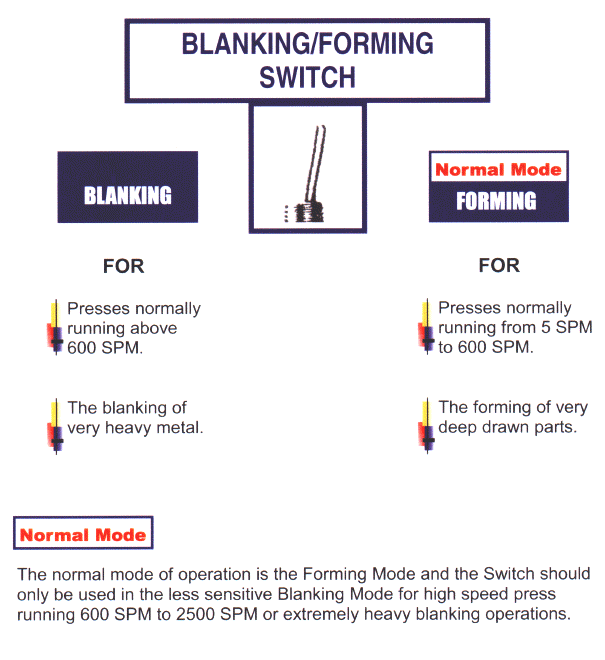PROFORCE
Installation and Operating Manual
TABLE OF CONTENTS
TABLE OF
CONTENTS
INTRODUCTION
OVERVIEW
SECTION I
TRANSDUCER BRACKET DRAWING
Page 1—Transducer Bracket Template with Mounting Dimensions
Page 2—Piezo Transducer Drawing with Dimensions
Page 3—Piezo Transducer with Cable Clamp on Press Frame
SECTION II
PIEZOELECTRIC TRANSDUCER INSTALLATION
Page 1—Piezo Transducer Mounting
Instructions
Page 2—Drawing for OBI, GAP, C-Frame & Press Brake
Page 3—Drawing Straight Side Press, Column Mounting 112G
Page 4—Drawing Straight Side Press, Pitman Mounting 112
Page 5—Drawing of Pitman Mounting Locations
SECTION III
TERMINAL BLOCK WIRING DESCRIPTIONS
Page 1—Terminal Block Points 1 - 4
POINT 1 - +24 Volt D.C.
POINT 2 - Grd. Input
POINT 3 - Grd. Output
POINT 4 - Analog Signature Output
Page 2—Terminal Block Points 5 - 9 TRANSDUCER INPUTS
Page 3—Piezoelectric Transducer Descriptions
Page 4—Terminal Block Points 10 - 12 CALIBRATING CAPACITORS
Page 5—Terminal Block Points 13 - 16
POINT 13 - Grd. (output to IMCO “Read Me” device)
POINT 14 - Peak Output
POINT 15 - +24 Volts (output to IMCO “Read Me” device)
POINT 16 - Cal (Calibrate)
Page 6—Terminal Block Points 17 - 19
POINT 17 - Trim Ref (Trim Reference)
POINT 18 - Peak Reset
POINT 19 - Display Reset
SECTION IV
CONNECTING PROFORCE I/O MODULE TO PLC
Page 1—Determining Cable Length, Minimizing
Electrical Noise Interference, Preparing The Cable
Page 2—Preparing The Cable, continued
Page 3—Wiring the Cable and Connecting to Proforce I/O Module,Minimizing Ground
Loops
SECTION V
BLANKING/FORMING SWITCH
Mode of Operation - Set Position of Switch To Blanking or Forming
INTRODUCTION
Our new, low cost small size
(100mm x 80mm x 25mm) Proforce Piezo I/O Module with Peak Indicating is D-Rail
mounted and work in conjunction with any manufactures PLC or Industrial PC. Proforce
Piezo I/O Module is used for one (1) channel of Load Monitoring. They can
work with any press tonnages or press speeds.
The Proforce Piezo I/O Module offers the ability to customize Load Monitoring
requirements by adapting customized software programs. They can program load
trip point for both Press and Dies. Hidden menus are easily created to monitor
press overload and die overloads for warranty purposes or other information that
may be required.
The Analog of the Proforce Piezo I/O Module feeds directly into the PLC or
Industrial PC, A to D Converter Board. The output signal is 0 - 10 Volts. - 24
Volt input.
All types of IMCO's Piezoelectric Transducers are used with the Proforce Piezo
I/O Module. Column mounted, Pitman mounted and "Satellite" In-Die Transducers
offer suitable mounting choices for the Proforce Piezo I/O Module.
FEATURES
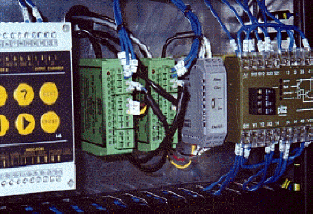
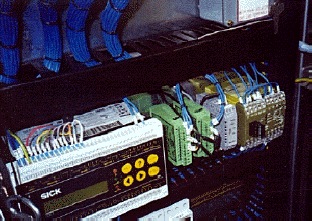
OVERVIEW
PROFORCE
PIEZO ANALOG-DIGITAL I/0 MODULE
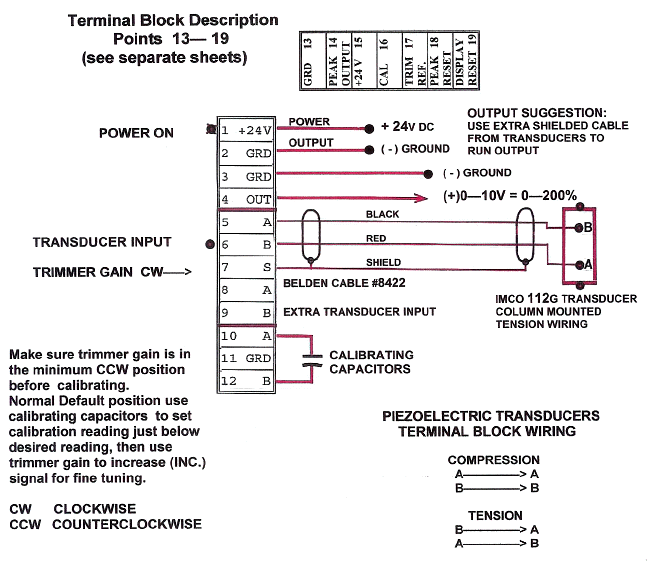
MODEL NO. PZO-30AP
SECTION I
TRANSDUCER BRACKET MOUNTING
Page 1
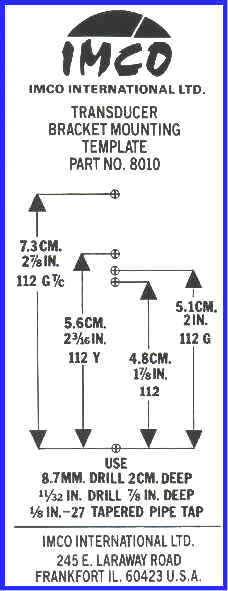 Stick-on
templates are supplied with all Proforce Piezo I/O Modules. Determine the
mounting bracket locations based on the type of piezoelectric transducers to be
used and the optimum output mounting location for piezoelectric transducers to
be used. . Attach template to the chosen location . Drill and tape the two
appropriate holes using the self-adhesive bracket mounting template (see
Template No. 8010 ) to determine correct hole spacing . Make sure
that in drilling the holes, the piezoelectric transducers will remain parallel
to the mounting surface (Example: column or pitman's). Use regular capacity 3/8
inch or 1/2 inch power drill; we suggest, if possible, a carbide tipped drill
bit, because the outer skin surface of the machine has a tendency to be tempered
hardened.
Stick-on
templates are supplied with all Proforce Piezo I/O Modules. Determine the
mounting bracket locations based on the type of piezoelectric transducers to be
used and the optimum output mounting location for piezoelectric transducers to
be used. . Attach template to the chosen location . Drill and tape the two
appropriate holes using the self-adhesive bracket mounting template (see
Template No. 8010 ) to determine correct hole spacing . Make sure
that in drilling the holes, the piezoelectric transducers will remain parallel
to the mounting surface (Example: column or pitman's). Use regular capacity 3/8
inch or 1/2 inch power drill; we suggest, if possible, a carbide tipped drill
bit, because the outer skin surface of the machine has a tendency to be tempered
hardened.
Use a 1/8 IN.— 27 Inch tapered (conical) pipe tape.
IMPORTANT: DO NOT SUBSITTUTE A NON TAPERED TAPE
After drilling and tapping the holes, apply a light oil or grease for lubrication and insert both top and bottom brackets; top brackets have the lock nuts and should be mounted on top. Jam brackets into frame with open end wrench so as to get square part of bracket body as close as possible to column or frame of Press . Do not remove the top bracket set screw when jamming into press frame. Make sure brackets are tight. Lock nuts should be “kissing” the frame or column.
NOTE:
Piezoelectric transducers are measuring micro strain in frame of Press. Brackets
should be tightened into Press frame as close as possible to assure maximum
piezoelectric transducer signal.
TORQUE TRANSDUCERS IN BRACKETS TO 15 INCH LBS.
SECTION I
TRANSDUCER BRACKET MOUNTING
Page 2
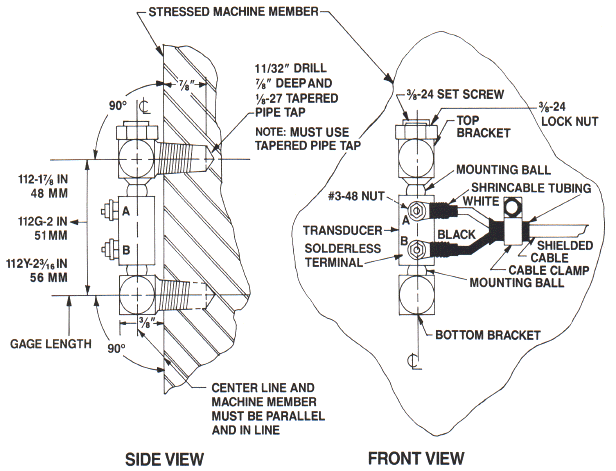
The IMCO Load Monitor and piezoelectric transducers are ruggedly built to withstand normal industrial environment conditions and require minimal maintenance. However, each system can benefit from careful use and maintenance. It is recommended that the following procedure be carried out at a minimum frequency of every three months.
TRANSDUCERS
Each piezoelectric transducer is factory
pre-wired and terminal connections sealed. A visual inspection of seal and
connections is all that is required. Torque piezoelectric transducers to 15
inch/lbs. at time of installation or before calibration. They should not come
loose even when located on a moving connection and subjected to heavy shock. You
can torque again to 15 inch/lbs., if any piezoelectric transducers screw becomes
loose and the original calibration is maintained. Check to see that top locknut
remains securely fastened. If loose, tighten with regular wrench. A small drop
of LockTite or similar fluid should avoid future loosening of locknut.
SECTION I
TRANSDUCER BRACKET MOUNTING
Page 3
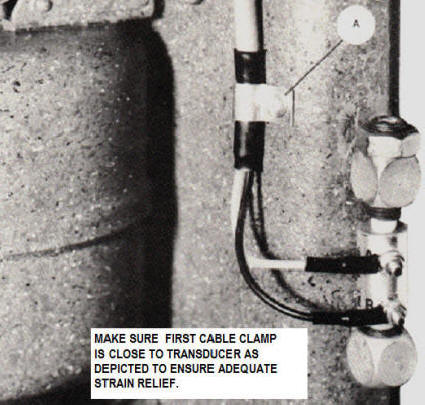
TRANSDUCER CABLES
Check to see if cables are in good condition and covering remains pliable. Cracked or damaged cable can cause erratic or lack of signal from piezoelectric transducers. Activation of each piezoelectric transducer is easily checked on press by sharply squeezing top and bottom piezoelectric transducer bracket. Hold sections between thumb and forefinger simulating a quick pressure on the piezoelectric transducer as when the press member is dynamically loaded. Appropriate meter needle (digital display) should indicate a response.
SECTION II
PIEZOELECTRIC TRANSDUCER
Page 1
INSTALLATION
IMPORTANT
Please Read
![]() Do not run any other AC or DC lines with the Piezoelectric
Transducer
wires. Keep them separate.
Do not run any other AC or DC lines with the Piezoelectric
Transducer
wires. Keep them separate.
![]() Before serviceman arrives for Calibration be sure
Proforce is mounted, power connected,
Before serviceman arrives for Calibration be sure
Proforce is mounted, power connected,
piezoelectric transducers are
mounted and connected to the Proforce I/O Module.
![]() Software program should be written for Press PLC or
Industrial PC is the responsibility of the user.
Software program should be written for Press PLC or
Industrial PC is the responsibility of the user.
![]() Record Proforce I/O Module serial number for future
reference.
Record Proforce I/O Module serial number for future
reference.
PIEZOELECTRIC TRANSDUCER MOUNTING INSTRUCTIONS
The following instructions are provided in a basic sequence for simplicity in installing the Piezoelectric Transducers on your machine . Please select appropriate reference to your type of machine and read entire sequence before installing your Piezoelectric Transducers.
The IMCO piezoelectric transducers supplied from the factory for all IMCO systems are shipped pre-wired. The standard pre-wired cables are determined by the mounting location either on the columns or pitman's of the press. Standard cable lengths for column or pitman mountings are applicable to most all types presses. Do not cut cable until length from transducers to the mounted Proforce I/O Module is determined. If the cable lengths are not long enough, custom cable lengths can be requested.
Typical mounting locations are recommended to obtain maximum output from IMCO piezoelectric transducers. While there are possible alternates, it is suggested that you contact the factory before selecting one. We do not advise pitman mounting if your pitman is split or it has an adjustment mechanism in the pitman.
The IMCO piezoelectric transducers are measuring micro strain. Brackets should be tightened and jammed into the press frame or pitman's as close as possible to assure maximum transducer signal. Make sure the brackets remain parallel to the mounting surface (i.e. columns or pitman's). Use the supplied mounting template to determine spacing distance between top and bottom mounting brackets.
SECTION II
OBI - GAP - C-FRAME - PRESS
BRAKES
Page 2
Column Mounting
112G Piezoelectric Transducer
IMCO piezoelectric transducers are normally placed, one at the back of each frame (see Figure No. 1) for simplicity of mounting. Each IMCO piezoelectric transducer is located between mounting brackets positioned approximately on a center line between the top and bottom of the gap, excluding any bolster plates. This location permits individual readout of peak load on each frame.
If for any reason the IMCO piezoelectric transducers cannot be located at the back of each frame, they can be placed on the pitman. Two IMCO piezoelectric transducers per pitman mounting connected in parallel will provide only a single channel of readout.
Note:
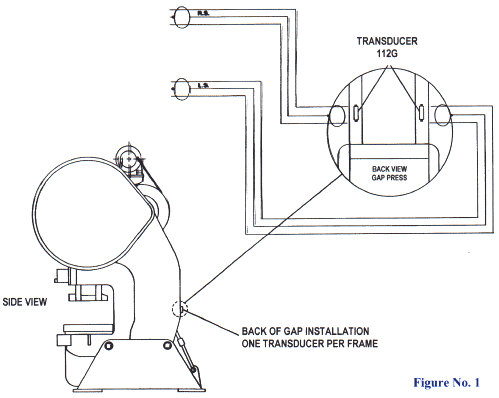
SECTION II
STRAIGHT SIDE PRESS
Page 3
Column
Mounting
112G Piezoelectric Transducers
Location of IMCO piezoelectric transducers on straight side presses should be on the columns front and back, (not the sides) away from keyways. One IMCO piezoelectric transducer for each column should be mounted approximately on a center line between the top of the ram and the bottom of the bed, excluding any bolster plates, to assure continued optimum output and positive response. (see Figure No. 2 and Figure No. 3).
Note: Do not substitute or splice in an alternate type cable.
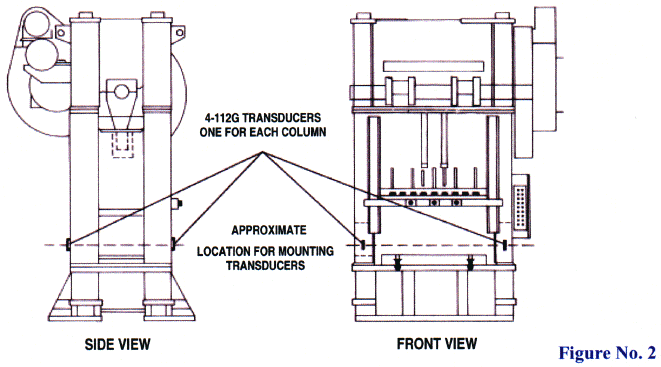
Use only Belden #1503A for Column Mounting
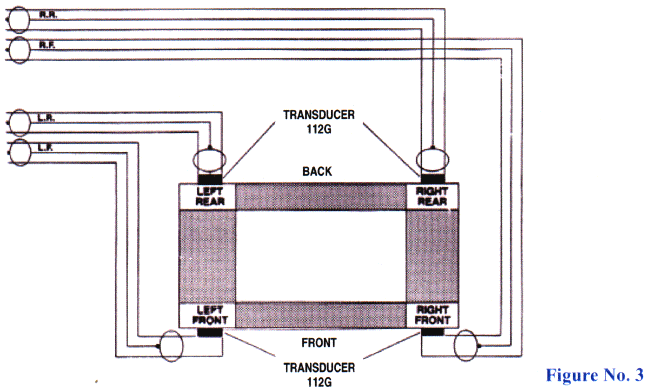
TOP VIEW - STRAIGHT SIDE PRESS
SECTION II
STRAIGHT SIDE PRESS
Page 4
Pitman Mounting
112 Piezoelectric Transducers
Note: Do
not substitute or splice in an alternate type cable.
Use only Belden #83319 for Pitman Mounting.
Attach two IMCO piezoelectric transducers on each pitman located 180 degrees from each other and as close to the directional axis of rotation as possible. Wiring will be in parallel. We do not advise pitman mounting if your pitman is split or it has an adjustment mechanism in the pitman. (see Figure No. 4, Figure No. 5, Figure No. 6 and Figure No. 7)
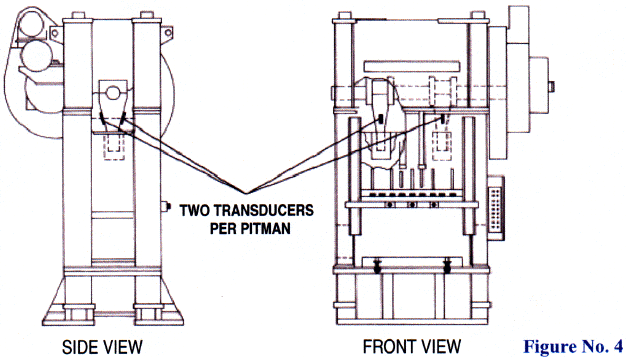
PITMAN VIEW
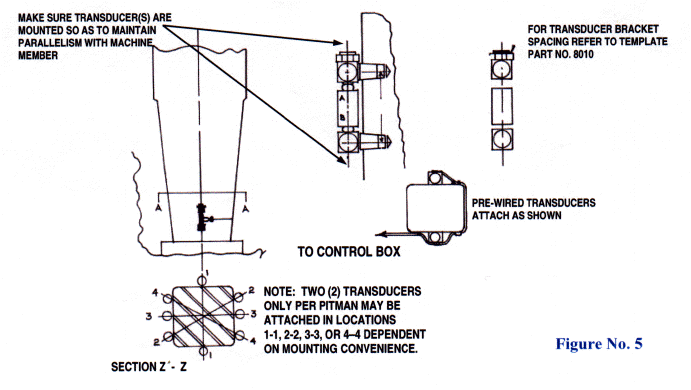
SECTION II
STRAIGHT SIDE PRESS
Page 5
Pitman Mounting
112 Piezoelectric Transducers
PITMAN VIEW
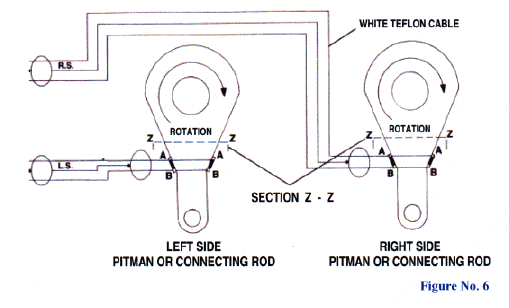
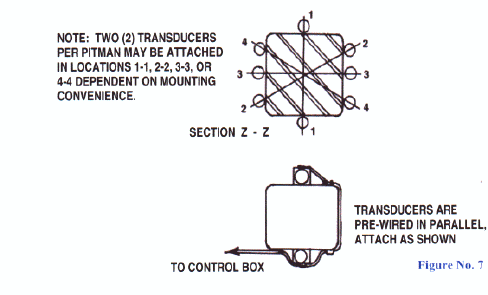
SECTION III
TERMINAL BLOCK POINTS
Page 1
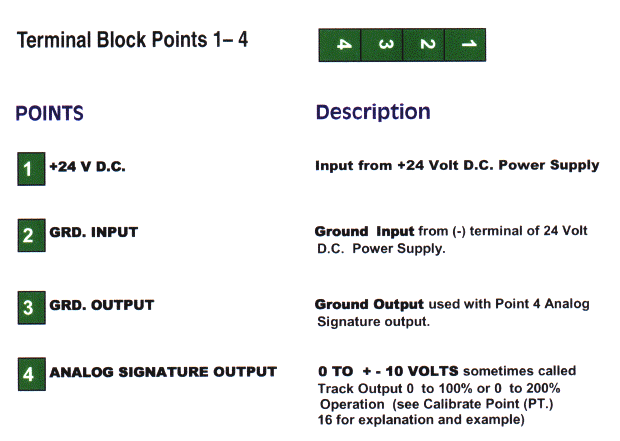
SECTION III
TERMINAL BLOCK POINTS
Page 2
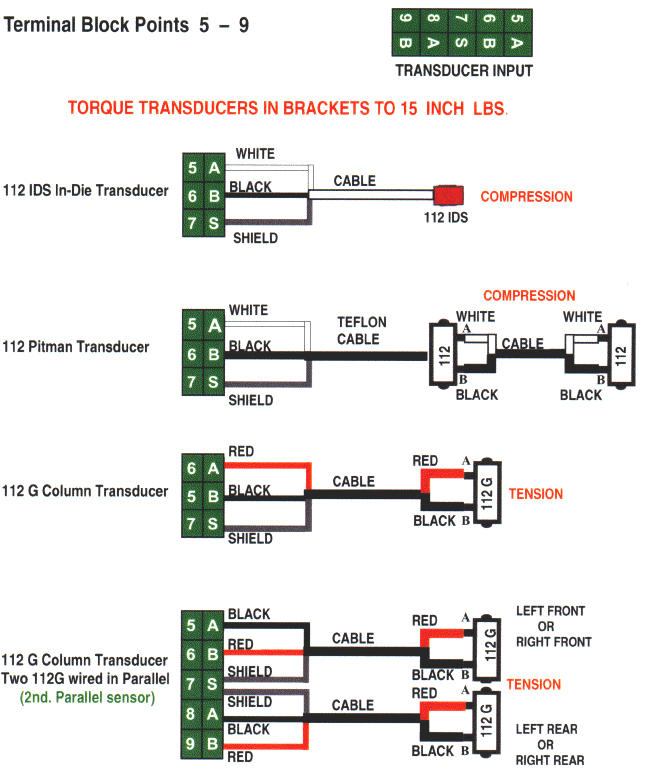
SECTION III
TRANSDUCER DESCRIPTIONS
Page 3
The Proforce Piezo I/O Module is capable of using any IMCO 112 Series Piezoelectric transducer and can be wired for tension or compression by switching the A + B points on the transducer input terminal block Points 5 through 9.
Transducer
Input
Terminal Block Points 5 - 9
![]()
112 IDS In-Die
Satellite Piezoelectric Transducer
112 Pitman Mounted
Piezoelectric Transducer
112 are used on the
connecting rods or pitman's of the press, because the stresses on the pitman's
are greater than on the columns. The lower output 112 transducer is suitable for
pitman mounting. Two (2) 112 transducers are pre-wired in parallel and mounted
on each pitman or connecting rod. One (1) 112 transducer is mounted on the front
of the pitman and the other is mounted on the back of the pitman, 180 degrees
apart in the direction of the rotation compensating for bending of the pitman.
Even though the 112 transducer is ideally suited for pitman mounting with its
lower output, it does not limit its mounting use in other areas. 112 transducers
are wired for compression with Teflon cable, which is impervious to oil and
maintains its flexibility. (wiring diagram “Terminal Block Points 5 through 9”,
separate sheet.)
112G Column Mounted
Piezoelectric Transducer
112G Column Mounted Transducer wired in parallel
(2nd Parallel Sensor)
SECTION III
TERMINAL BLOCK POINTS
Page 4
Calibrating Capacitors
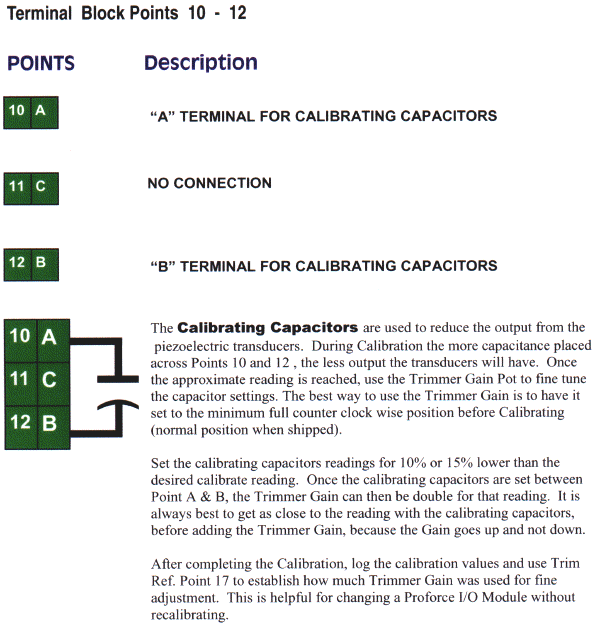
SECTION III
TERMINAL BLOCK POINTS
Page 5

SECTION III
TERMINAL BLOCK POINTS
Page 6
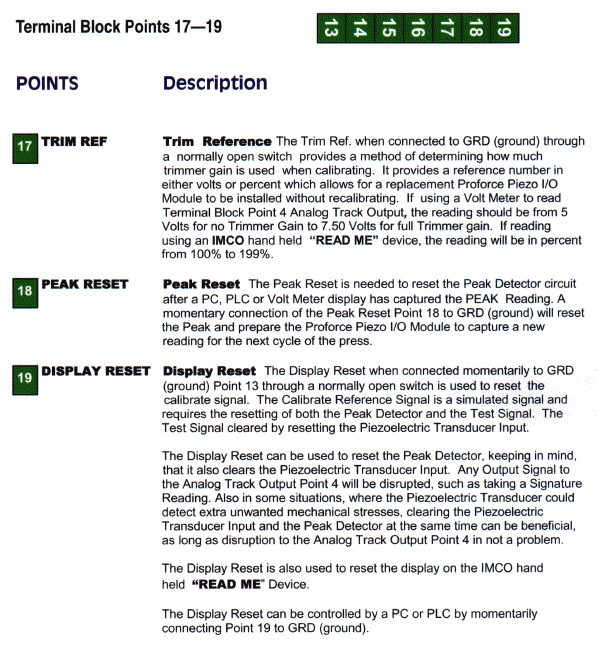
SECTION IV
CONNECTING TO I/O MODULE TO PLC
Page 1
DETERMINING CABLE LENGTH
When you determine the length of cable
required to connect Proforce I/O Module, remember to include additional length
to route the drain wire and foil shield to earth ground. Route cable long enough
to avoid signal attenuation.
MINIMIZING ELECTRICAL NOISE
INTERFERENCE
High speed analog signals are particularly
vulnerable to electrical noise. Take precautions when routing signal cables. To
help reduce the effects of electrical noise on analog signals, we recommend that
you:
![]() Install the PLC AND Proforce
I/O Module in a NEMA rated enclosure.
Install the PLC AND Proforce
I/O Module in a NEMA rated enclosure.
![]() Make sure that the PLC and Proforce I/O
Module is properly grounded.
Make sure that the PLC and Proforce I/O
Module is properly grounded.
![]() Use Belden cable # 1503A, # 8451 or #8761
(or equivalent) for signal wiring.
Use Belden cable # 1503A, # 8451 or #8761
(or equivalent) for signal wiring.
![]() Ground the cable properly.
Ground the cable properly.
![]() Route signal cables away from other
wiring or in grounded conduit.
Route signal cables away from other
wiring or in grounded conduit.
![]() Group Proforce I/O Modules away from AC
or high-voltage DC modules.
Group Proforce I/O Modules away from AC
or high-voltage DC modules.
We recommend re-checking Proforce I/O modules
operation after installing new machinery or
other sources of electrical noise near the I/O Modules.

ATTENTION:
Before wiring a Proforce I/O Module, disconnect Power from
the I/O Module and from any Power other Power source to the Module.
PREPARING THE
CABLE
1. At
each end of the cable, strip about 3 inches ( 76.19 mm) of casing to expose the
wires.
2. At the ground end of the cable (Figure 1), twist the drain wire and the foil
shield
together and bend them away from the cable. Using a hot air blower, apply
shrink wrap
where wires leave the casing.
3. At the other end of the cable, cut off the drain wire and foil shield. Apply
shrink wrap to
the junction where wires leave casing.
4. Trim the signal wires to 2 inch (50.8 mm) lengths. Strip about 3/16 inch
(4.76 mm) of
insulation away to expose the copper strands for connections.
5. Decide where you will connect the cable to earth ground, and ground it. Refer
to
GROUNDING THE
CABLE.
6. Connect signal wire (black and white) to terminal block and to input or
output device.
(see separate sheets for Wiring Terminal Block Points 1 through 19).
SECTION IV
CONNECTING TO I/O MODULE
TO PLC
Page 2
Continued: Preparing
The Cable
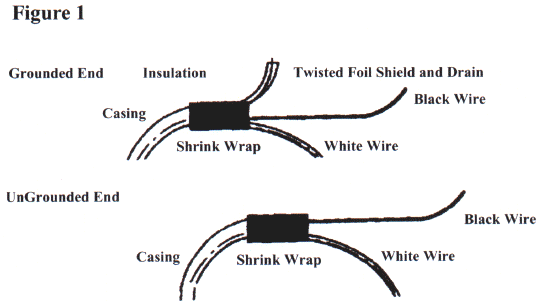
Repeat steps 1— 6 for each channel.
For each unused input channel, follow your A to D Board Instruction Manual.
GROUNDING THE
CABLE
Signal cable such as Belden #1503A, #8451
and #8761 ( or equivalent) has two signal wires (black and white), one drain
wire and a Foil shield (Figure 2). The drain wire and foil shield must be
grounded at only one end of the cable, not at both ends.
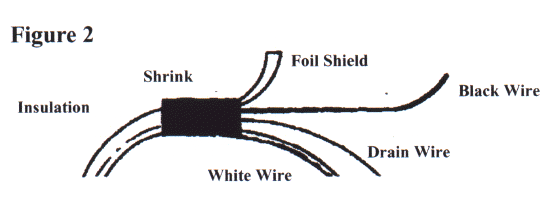
IMPORTANT: Ground the cable shield at one end having a good earth ground connection, such as at an I/O chassis mounting bolt or nearest ground bus in the I/O enclosure. Make this connection as short as possible. Do not ground the cable at the input to the A to D Board.
SECTION IV
CONNECTING TO I/O MODULE
TO PLC
Page 3
WIRING THE CABLE

ATTENTION:
Before wiring the Proforce I/O Module, disconnect PLC
System power, I/O Rack power, and module power.
CONNECT TO PROFORCE I/O MODULE
Use appropriate terminal block
points, depending on the speed of A to D Board.
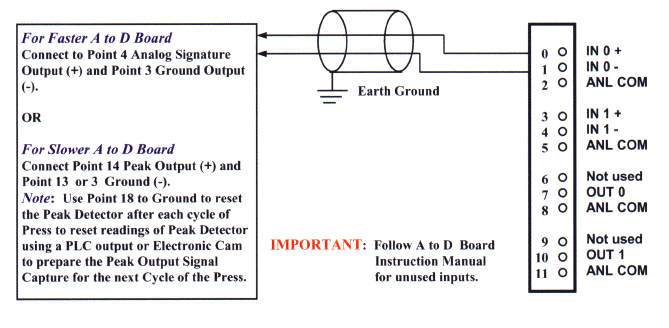
MINIMIZING GROUND LOOPS
To keep the ground-loop current of input
circuits to a minimum, we recommend that you:
![]() Use the same power supply to power both input channels of a Proforce I/O Module
Use the same power supply to power both input channels of a Proforce I/O Module
![]() Or Tie together the grounds of separate power supplies.
Or Tie together the grounds of separate power supplies.
SECTION V BLANKING/FORMING SWITCH
